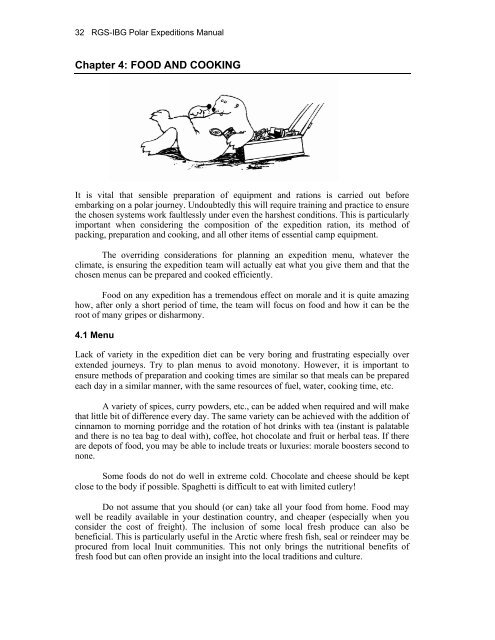Edited by Rachel Duncan 4th Edition ISBN 0-907649-91-2 London ...
Edited by Rachel Duncan 4th Edition ISBN 0-907649-91-2 London ...
Edited by Rachel Duncan 4th Edition ISBN 0-907649-91-2 London ...
Create successful ePaper yourself
Turn your PDF publications into a flip-book with our unique Google optimized e-Paper software.
32 RGS-IBG Polar Expeditions Manual<br />
Chapter 4: FOOD AND COOKING<br />
It is vital that sensible preparation of equipment and rations is carried out before<br />
embarking on a polar journey. Undoubtedly this will require training and practice to ensure<br />
the chosen systems work faultlessly under even the harshest conditions. This is particularly<br />
important when considering the composition of the expedition ration, its method of<br />
packing, preparation and cooking, and all other items of essential camp equipment.<br />
The overriding considerations for planning an expedition menu, whatever the<br />
climate, is ensuring the expedition team will actually eat what you give them and that the<br />
chosen menus can be prepared and cooked efficiently.<br />
Food on any expedition has a tremendous effect on morale and it is quite amazing<br />
how, after only a short period of time, the team will focus on food and how it can be the<br />
root of many gripes or disharmony.<br />
4.1 Menu<br />
Lack of variety in the expedition diet can be very boring and frustrating especially over<br />
extended journeys. Try to plan menus to avoid monotony. However, it is important to<br />
ensure methods of preparation and cooking times are similar so that meals can be prepared<br />
each day in a similar manner, with the same resources of fuel, water, cooking time, etc.<br />
A variety of spices, curry powders, etc., can be added when required and will make<br />
that little bit of difference every day. The same variety can be achieved with the addition of<br />
cinnamon to morning porridge and the rotation of hot drinks with tea (instant is palatable<br />
and there is no tea bag to deal with), coffee, hot chocolate and fruit or herbal teas. If there<br />
are depots of food, you may be able to include treats or luxuries: morale boosters second to<br />
none.<br />
Some foods do not do well in extreme cold. Chocolate and cheese should be kept<br />
close to the body if possible. Spaghetti is difficult to eat with limited cutlery!<br />
Do not assume that you should (or can) take all your food from home. Food may<br />
well be readily available in your destination country, and cheaper (especially when you<br />
consider the cost of freight). The inclusion of some local fresh produce can also be<br />
beneficial. This is particularly useful in the Arctic where fresh fish, seal or reindeer may be<br />
procured from local Inuit communities. This not only brings the nutritional benefits of<br />
fresh food but can often provide an insight into the local traditions and culture.

















